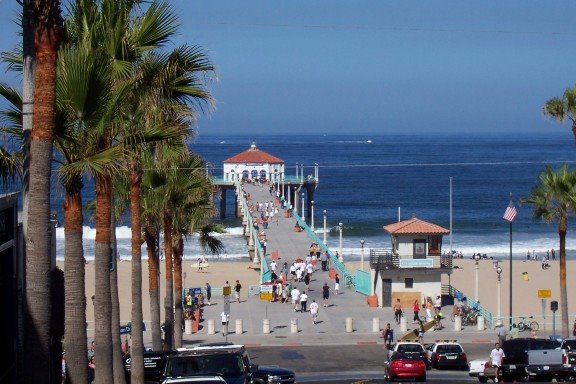
I wrote a post 10 days ago about buying in the Beach Cities...Manhattan Beach-Beach Cities.... You Need Bucks to Buy. I was surprised at how many people read more into the post then I had intended. One of those who commented was Pablo. He posed a number of questions. I decided to post one of his comments and my answers as a new post because I suspect that many people have similar questions..
Pablo's comment:
I think what frustrates some of us is:
1) we saw many housing pro's including yourself bring up the new(passed in Feb by congress) 'junior jumbos' that were backed 'fannie' and 'freddie' to prop up the sales . Who said these 'junior jumbos' would be offered at similar rates as conforming loans ??, now realtors complain that they aren't !
2) we (from realtors) hear interest rates are at historical lows , buy now , because they could rise . you, mention that in early 80's that prices were stable even with high interest rates . Let me ask this , do you think think prices will stay flat with the prospect of higher rates, and larger downpayments required . I don't!
3) probably what is most frustrating for some of us ,is this statement "The south bay is different ". Yes , it is stronger , yes it is wealthier . but how can prices erode IE , OC and not affect south bay ? if prices drop in Riverside , then GARdena, then Torrance then Redondo ..... .. doesn't it have to affect MB and HB ??I do agree that prime , prime , strand and sand , will stay up . but what is that 10-20 % of housing stock in MB and HB ?
My Answer:
I'll try to answer your questions in order..
1. The whole idea behind the increase in conforming loan limits was that these loans would be priced approximately the same as $417,000 loans.. maybe a half point higher but within the range and less then rates were on Jumbos at that time....The increase was supposed to level the playing field for communities with high home prices. Lenders took money from FEDS at lower rates and then basically stuck it to the government. The credit markets are controlling the economy and no one is willing to take on banks over the issue. The banks continue taking in money at low rates from the FED but are not lending it to the markets the FED and Congress expected to target.
2. No one is saying buy now because rates are low.. you should never buy a home unless you can afford to buy. However if you are thinking of buying in the near future then I believe you should take rates into account along with prices. Only taking in one variable makes little sense. This is really true if prices decline only slightly(5%-7%) over the next few months.
Why is it that so many people believe that higher down payment requirements are going to be catastrophic? In the 80's you had to have 20% down.. this isn't new. Prices may have been lower but people made less money so it may likely equal out over 20+ years. It's only been in the last 5-6 years that you could buy with less then 10-20% down unless you were using VA or FHA financing. I suspect you would be surprised at how many people actually do have 10%-20% cash for a down payment.
My personal opinion is that rates will go up after the election unless we can get inflation under control. However the current market is different then the one preceding the rise in rates in the late 70's and early 80's. I believe that if rates do not rise above 7% the market will continue to soften into next year and then flatten for about 3 years. If interest rates rise to 9% or more then prices will no doubt continue to decline for at least another year or two.
3. Here's how prices can erode in the IE, Riverside and San Bernardino while continuing to maintain a certain degree of value in our area. First the IE is not near any of the major job centers. The big industry in those areas for the last few years was home construction. The area has few jobs that can support new residents. The houses were built a long way from major job centers. These homes were target to people who couldn't afford to buy in the metro areas of LA County. At $4.00+ per gallon for gas consumers can't afford the gas to get to work or the payment on the house. If anything consumers are trying to find housing that is closer to jobs not farther away.
This has always been one of the main attractions of the Beach Cities... they are convenient to LAX and most of the major financial markets in Los Angeles. Aerospace companies are blocks away not a hundred mile commute. There are a number of companies in the LA metro area that employ thousands of people. Given the option on where to live many pick coastal communities.
Those who choose to live in our area generally are fairly stable financially... otherwise they couldn't afford to live here. However that doesn't mean there are not problems in the Beach Cities.. there are.. just not on the scale you find in other areas where the population is not as financially independent. The truth is that most of the people who bought in the last few years in the Beach Cities are not in dire financial straits. A percentage are in trouble but not nearly as many as those in other areas. This is why there are not large numbers of foreclosures in our local market. If a lot of people lose their jobs that could change... but as long as most of the population stays employed and spends wisely we won't be in the same shape as other areas of Los Angeles.
Finally North Redondo is often the gage for the health of the Beach housing market. Prices have dropped but the market is still pretty stable. There are more foreclosures in North Redondo then in South Redondo or Hermosa or Manhattan but the numbers are still relatively small. Most people who bought in Redondo could afford their homes. However many who bought in the IE, Harbor Gateway, Gardena, Hawthorne, Lawndale and San Pedro who are in trouble, could not afford to buy and should not have purchased a home. Often there were 3-5 people on title. If just one person walked away, the others were in trouble. You rarely see that in the Beach communities.
Ultimately the housing downturn does affect all of us.. including the Beach Cities. We are not immune we just don't seem to be in as much trouble at this time. This is not a bad thing. It makes sense to buy a home in a stable community that will continue to hold value over the years. Given the choice between buying in a South Bay Beach community and the IE... most would choose the Beach community.





4 comments:
kaye
You are thorough ,if I needed a realtor ....
I agree there is a disconnect with banks and credit . but after last 5-6 years what could we really expect ?(as I said earlier my pal making 80 k was offered 1 million loan by countrywide rep )
I may underestimate the amount of buyers who have 20% or more , but with a soft to declining market, the barrier to entry (down payment) ....doesnt help stabilize an already weak market . (credit crunch started late summer 07 , mkt softened before)
No doubt about it Beach cities will hold up better . Though , I reckon a patient shopper with $$ will come across some great deals , especially off season . ( job transfers , personal issues etc.)
Pablo,
I'm glad I could answer some of your questions.. I suspect you are right that a few smart shoppers will find some good deals in this market..
Kaye, I'd like to argue against your point number 1. I don't think that the purpose of the "conforming jumbo" loans was to offer higher valued loans at a similar rate as full-on conforming loans. The purpose was to allow loans in the jumbo conforming range to be made at all. When the credit crunch hit in full effect, jumbos were very hard to obtain. Investors just didn't want to lend out their money. So congress decided to allow freddie and fannie to provide capital to make these loans, not necessarily at rates similar to conforming loans. Even when freddie and fannie are providing the capital, the rates are still set by the market, and since investors are still leery of higher-than-conforming loans, the prices end up higher.
Another off-topic comment. It will be interesting to see what happens here in the next 10-15 years regarding the local aerospace companies (I work at one of them). The distribution of employees is bimodal... lots of older workers close to retirement and lots of young new workers, but few in-between. A lot of this has to do with the downturn in the 90s which flushed out a lot of new folks who would have been in the middle now. As the older folks retire in the coming years, the workforce will be younger. And I can tell you from experience that it is very difficult to recruit new hires to work in southern california due to the home prices, and of those who do come, many leave for cheaper regions within a few years. I personally know of many younger (ages ~25-30) people who have done this. Even though they like it here, they can't afford a decent house close to work and, frustrated, they move away.
My point here is this... I wonder what the landscape will look like 5-10 years from now? The pool of home buyers from the aerospace companies may not be nearly as big as it is now, and the pool of first time buyers may be very, very small.
Dav,
You make a good point and certainly that was one of the reasons for the higher conforming rates. However jumbo loans were being made.. you just had to go with a higher interest rate..and 20% down just like today.
The main purpose of the higher conforming loans was to help higher priced areas by generating a higher limit conforming loan that could be sold to the secondary market just like regular conforming loans. The biggest drawback to the loans was the temporary limited time of the funding.. 6 months... no one wanted to touch such a limited loan. That's one of the reasons Congress is passing legislation to make the loan limits permanent.
Actually the rates on the conforming jumbos today are about the same as regular jumbo rates which means that they are not as attractive to buyers. It also means that not many of these loans are being funded as they are no better then regular jumbos.
I suspect that the aerospace industry may become a smaller part of the overall job market in our area in the next 10 years. Our economy is far more diversified then it was in the 80's and 90's. I have far fewer first time buyers from aerospace then I did even 5 years ago.
Guess we will have to compare notes in 10 years...
Post a Comment